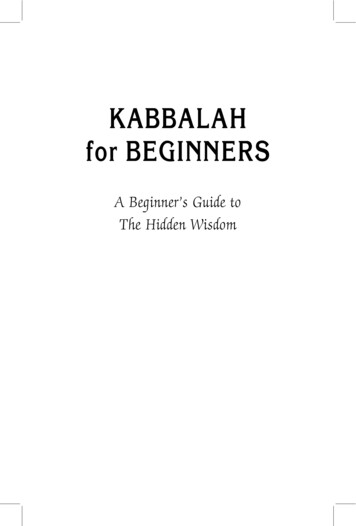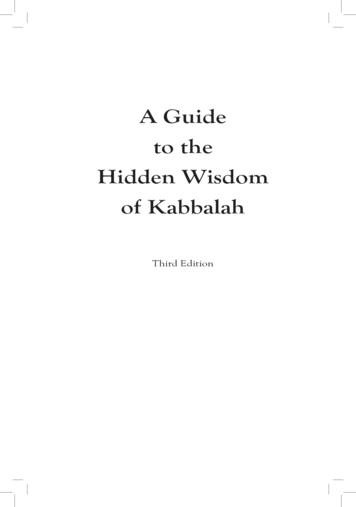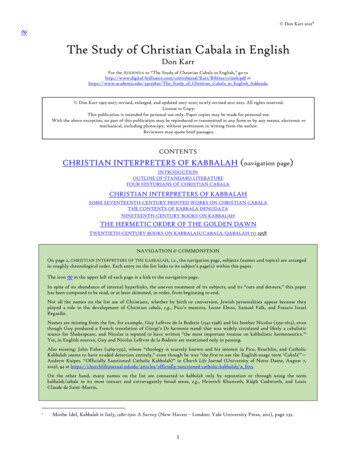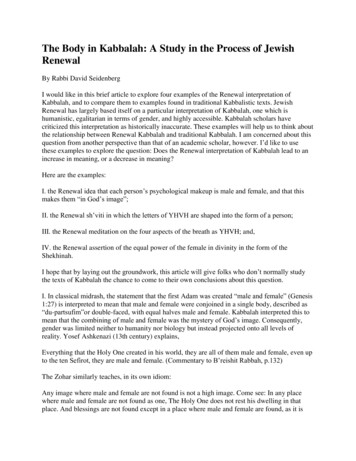
Transcription
KABBALAHfor BEGINNERSA Beginner’s Guide toThe Hidden Wisdom
KABBALAHfor BEGINNERSA Beginner’s Guide toThe Hidden WisdomBYRABBI MICHAEL LA I T M A NCOMPILED BY BENZION GIERTZLAITMANKabbalahPublishers
Executive Editor: Benzion GiertzLaitman Kabbalah Publishers Website:www.kabbalah.infoLaitman Kabbalah Publishers Email:info@kabbalah.infoKABBALAH FOR BEGINNERSCopyright ! 2002 by MICHAEL LAITMAN.All rights reserved. Published by Laitman Kabbalah Publishers,127 Ramblewood Lane Thornhill, ONT. L4J 6R3, Canada.Printed in Canada. No part of this book may be used orreproduced in any manner without written permission of thepublisher, except in the case of brief quotations embodied incritical articles or reviews.ISBN: 0-9732315-3-XThird Edition: April 2004
ContentsAbout the Book . . . . . . . . . . . . . . . . . . . . . . . . . . . . . . . . . . . . . . 9Introduction . . . . . . . . . . . . . . . . . . . . . . . . . . . . . . . . . . . . . . . . 11Chapter 1 What is Kabbalah? . . . . . . . . . . . . . . . . . . . . . . . . . . . . 15Chapter 2 Why Study Kabbalah? . . . . . . . . . . . . . . . . . . . . . . . . . 18Chapter 3 Who is a Kabbalist? . . . . . . . . . . . . . . . . . . . . . . . . . . . 21Chapter 4 The History of Kabbalah and The Zohar . . . . . . . . . . . 23Chapter 5 Who Can Study Kabbalah? . . . . . . . . . . . . . . . . . . . . . . 30Chapter 6 How To Study Kabbalah . . . . . . . . . . . . . . . . . . . . . . . 32Chapter 7 Spirituality and Kabbalah . . . . . . . . . . . . . . . . . . . . . . . 38Chapter 8 Reincarnation and Kabbalah . . . . . . . . . . . . . . . . . . . . 39Chapter 9 The Language of Kabbalists: Branches . . . . . . . . . . . . . 45Chapter 10 Sensing Reality through Kabbalah . . . . . . . . . . . . . . . 48Chapter 11 Kabbalistic Music . . . . . . . . . . . . . . . . . . . . . . . . . . . . 53Chapter 12 FAQs About Kabbalah . . . . . . . . . . . . . . . . . . . . . . . . 55Other Books by Rabbi Michael Laitman . . . . . . . . . . . . . . . . . . . 62About Bnei Baruch . . . . . . . . . . . . . . . . . . . . . . . . . . . . . . . . . . . 63How to Contact Bnei Baruch . . . . . . . . . . . . . . . . . . . . . . . . . . . 64
About the BookT he Kabbalist Rabbi Laitman, who was the student andpersonal assistant to Rabbi Baruch Ashlag from 1979-1991,follows in the footsteps of his rabbi in passing on the wisdomof Kabbalah to the world. This book is based on sources thatwere passed down by Rabbi Baruch’s father, Rabbi YehudaAshlag (Baal HaSulam), the author of ‘‘the Sulam,’’ thecommentaries on The Book of Zohar, who continued theways of the Ari and Rabbi Shimon Bar Yochai and manygreat Kabbalists throughout the generations before them.The goal of this book is to assist individuals inconfronting the first stages of the spiritual realm. Thisunique method of study, which encourages sharing thiswisdom with others, not only helps overcome the trialsand tribulations of everyday life, but initiates a process inwhich individuals extend themselves beyond the standardlimitations of today’s world.Benzion GiertzExecutive Editor-9-
IntroductionT he laws of nature, our place in the world and our behaviorhave been studied by scientists and philosophers for thousandsof years.Along with logical assumptions, science uses quantifiableresearch and data. Yet our scientists and researchers havediscovered that the more they advance in their research, themore obscure and confusing they find the world to be.Science has undoubtedly brought enormous progress intothe world, yet it is limited. Scientific tools cannot measureman’s inner world, his soul, behavior and sources of motivation. Man, the major component of the creation, is still leftwithout knowledge about his role in this universe.Man has always looked for answers to the basic questions oflife: Who am I? What is the purpose of my being here? Whydoes the world exist? Do we continue to exist after ourphysical being has completed its tasks?In this world of constant pressure, some find temporarysatisfaction in Eastern techniques, measures aimed at relaxation, or reducing suffering by minimizing personal expectations and desires. Various forms of meditation, nutrition, andphysical and mental exercise quiet man’s natural instincts andenable him to feel more comfortable from the point of view ofhis physical state. This process teaches him to lower hisexpectations, yet leaves him in conflict with his true desires.Our life experience teaches us that we have unlimiteddesires—and only limited resources to satisfy them. This isthe primary reason there is no way to completely satisfy allour desires and therefore avoid suffering. That is the subjectof Kabbalah. Kabbalah answers the basic questions of life- 11 -
KABBALAH FOR BEGINNERSand guides us toward achieving unlimited satisfaction on adaily basis.The essential questions of man’s being add anotherdimension to human suffering. They do not allow us to feelsatisfied even when this or that goal has been fulfilled. Whenone attains the goal he strives for, he immediately feels he’smissing yet another pleasure. This prevents him from enjoyinghis achievements, and his suffering is renewed. In retrospect,he sees that he has spent most of his time making an effort toachieve his goals, and has gained very little pleasure from thesuccesses themselves.Everyone, each in his own way, tries to answer thesequestions from the sources of information at his disposal. Eachone of us formulates our own perception of the world basedon our experience. Reality and everyday life constantly putthis perception to the test, making us react, improve, orotherwise change it. With some of us, this process occurs on aconscious level; with others it happens unconsciously.Kabbalah reaches out to all those who are seeking awareness. It teaches you how to add an essential feeling of thespiritual sphere—the sixth sense—that will affect your life inthis world. This will allow you to perceive the upper world—the Creator—and to gain control over your life.The Bible, The Zohar, The Tree of Life and other authenticspiritual sources were set down in order to teach us how toprogress in the spiritual realms, to study them and to receivespiritual knowledge. They explain how to set out on a path tospiritual ascent in this world. Over the generations, Kabbalistshave written many books in various styles, each in accordancewith the era in which they lived.In total, four languages were created to introduce us to ourspiritual reality: the language of the Bible (which includes theFive Books of Moses, the Prophets and the Scriptures), the- 12 -
Introductionlanguage of legends, a legalistic language, and the language ofKabbalah, which describes the spiritual upper-worlds systemand how to reach it. The differences in languages simplypresent various perspectives on the same subject in differentformats—each suiting the generation it was intended for.The Kabbalist Baal HaSulam writes in his book Fruits ofthe Wise:The inner wisdom of Kabbalah is the same as that ofthe Bible, The Zohar and the legends, with the onlydifference between them being the manner of the logic. Itis rather like an ancient tongue translated into fourlanguages. It is self-evident that the wisdom itself did notchange at all due to the change in language. All we needto consider is which is most convenient and widelyaccepted for conveyance.By reading this book, you will be able to take your firststeps in understanding the roots of human behavior and thelaws of nature. The contents present the essential principles ofthe Kabbalistic approach and describe the wisdom of Kabbalah and the way it works. Kabbalah for Beginners is intendedfor those searching for a sensible and reliable method ofstudying the phenomena of our world, for those seeking tounderstand the reasons for suffering and pleasure, for thoseseeking answers to the major questions of life.- 13 -
Chapter 1What is Kabbalah?K abbalah is an accurate method to investigate and defineman’s position in the universe. The wisdom of Kabbalah tells usthe reason why man exists, why he is born, why he lives, whatthe purpose of his life is, where he comes from and where he isgoing after he completes his life in this world.Kabbalah is a method of reaching the spiritual world. Itteaches us about the spiritual world, and by studying it, wedevelop another sense. With the help of this sense we can bein touch with the upper worlds.Kabbalah is not a theoretical study, but a very practical one.Man learns about himself, who he is, what he is like. He learnswhat he needs to do to change himself stage by stage and stepby step. He conducts his research through his inner self.All experimentation is conducted on himself, withinhimself. That is why Kabbalah is called ‘‘The HiddenWisdom.’’ Through Kabbalah a person undergoes internalchanges that only he feels and knows are taking place. Thisactivity occurs within a person; it is unique to him, and onlyhe knows about it.The word Kabbalah comes from the Hebrew wordlekabbel, to receive. Kabbalah describes the motives of actionsas ‘‘the desire to receive.’’ This desire refers to receivingvarious kinds of pleasure. In order to receive pleasure, aperson is usually willing to invest great effort. The question is,how can one attain the maximum amount of pleasure whilepaying a minimum price for it? Everyone tries to answer thisquestion in his own way.- 15 -
KABBALAH FOR BEGINNERSThere is a certain order to the way the desire to receivedevelops and grows. In the first stage, man lusts after physicalpleasure. Then he seeks money and honor. An even strongerdesire makes him thirst for power. He may later develop adesire for spirituality, which is at the peak of the pyramid. Aperson who recognizes how great his desire for spiritualitybegins to seek ways of satisfying this desire.The passage through the stages of the desire to receivemakes a person become familiar with his abilities andlimitations.Kabbalah deals with the upper worlds, the roots of ourfeelings and thoughts, which we cannot grasp. Since we haveno control over the worlds, we do not know how and whyour feelings and thoughts are created. We wonder at experiences such as sweet, bitter, pleasant, rough and so forth.We are unsuccessful at building scientific tools to examineour feelings, even in the field of psychology, psychiatry andother social disciplines. Behavioral factors remain hiddenfrom our understanding.Kabbalah is a system for scientifically evaluating ourfeelings: It takes the total of our feelings and desires, andprovides an exact scientific formula for each and everyphenomenon, at each level, for every type of understandingand feeling.This is the work of feelings combined with intellect. Ituses, for beginning students, geometry, matrices and diagrams. When studying Kabbalah, they recognize each oftheir own feelings and begin to understand it. They knowwhat name it should be given according to its power, direction and character.The wisdom of Kabbalah is an ancient and proven method.Through it, man can receive higher awareness and attainspirituality. This is really his goal in this world. When a person- 16 -
What is Kabbalah?feels a desire for spirituality, he starts to feel a longing for it,and can then develop the desire through the wisdom ofKabbalah that has been provided by the Creator.Kabbalah is a word that describes the aim of the Kabbalist:to attain everything man is capable of, as a thinking being, thehighest of all creatures.- 17 -
Chapter 2Why Study Kabbalah?When an ordinary person studies the writings of theKabbalists, he learns about what was formerly hidden fromhim. Only after acquiring the sixth sense through study does hebegin to feel and see what was previously unrevealed.Everyone has a natural ability to develop this sixth sense,and that is the reason Kabbalists transmit their knowledge ofthe structure of the upper, spiritual world. [See the chapteron ‘‘Sensing Reality through Kabbalah.’’]When a person is exposed to Kabbalistic materials, he maynot at first grasp what he is reading. But if he wants tounderstand, and tries to do so in the proper manner, heinvokes what is called the Surrounding Light, the light thatcorrects him; and very gradually he is shown his spiritualreality. The terms ‘‘to correct’’ and ‘‘correction’’ are used inKabbalah to describe a change in the desire to receive, i.e., toacquire the qualities of the spiritual world and of the Creator.Everyone has this sixth, still-dormant spiritual sense; thisis called the point of the heart. Opposite it stands thelight, which will eventually fill the point, the sixth sense,when it develops.The sixth sense is also called the spiritual Vessel (Kli), andit continues to exist even without material reality. Thespiritual Vessel of the ordinary person who has never studiedKabbalah is not sufficiently developed to feel the spiritualworld. When he studies the original Kabbalah writings in theproper way, this light enlightens the point of the heart andbegins to develop it. The point then begins to widen and it- 18 -
Why Study Kabbalah?expands sufficiently to allow the Surrounding Light to enterit. When the light enters into the point of the heart, it gives aperson a spiritual feeling. This point is the person’s soul.Nothing is possible without help from the upper world,without the Surrounding Light descending from above andgradually lighting the way for a person. Even when we do notrecognize this light, there is a direct connection between thepoint of the heart and the light due to fill it, as planned fromabove. Studying Kabbalah books enables a person to connectto the source of the light, and gradually come to feel a desirefor spirituality. This process is called segula (remedy).Rabbi Yehuda Ashlag wrote in the Introduction to theStudy of the Ten Sefirot:Accordingly, why did the Kabbalists instruct everyoneto study Kabbalah? While it is great and worthwhilepublicizing that there is an incomparably wonderfulquality to studying Kabbalah wisdom, even though theydo not know what they are studying, it is the tremendousdesire to understand what they are studying that awakensthe lights surrounding their soul. That means that everyperson is assured the possibility of eventually attaining allthe wonderful achievements the Creator intended for usin planning Creation.Those who do not attain them in this incarnation willdo so in another, until the Creator’s intention is fulfilled.Even if a person does not achieve this completion, thelights are destined to be his; the Surrounding Lights waitfor him to prepare his Vessel to receive them. Therefore,even when he lacks the Vessels, when a person is engagedin this wisdom and recalls the names of the lights andVessels waiting and belonging to him, they will shine onhim but only to a certain degree. But they will notpenetrate his inner soul, since his Vessels are not yet- 19 -
KABBALAH FOR BEGINNERSready to accept them. Kabbalah is the only means tocreate the Vessel to receive the light of the Creator. Thelight he receives when he is engaged in the wisdomimparts to him a grace from above, bestowing anabundance of holiness and purity on him, bringing himcloser to reaching completion.Kabbalah is special in that it gives a person a taste ofspirituality while he is studying, and from that experience hecomes to prefer spirituality to materialism. In proportion tohis spirituality, he clarifies his will and learns to distancehimself from things he was once attracted to, much as an adultis no longer attracted to childish games.Why do we need Kabbalah? Because Kabbalah is given tous as a springboard for change. It is given to us so that we canknow and perceive the Creator at any given momentthroughout the day. These are the only reasons why thewisdom of Kabbalah was provided. Whoever learns Kabbalahin order to alter himself and improve himself, in order to knowthe Creator, reaches the stage in which he begins to see he canimprove, and fulfill his true destiny in this lifetime.- 20 -
Chapter 3Who is a Kabbalist?T he Kabbalist is a researcher who studies his nature using aproven, time-tested and accurate method. He studies theessence of his existence using tools we can all utilize—feelings,intellect and heart.A Kabbalist looks like an ordinary person. He need nothave any special skills, talents, or occupation. He need not bea wise man or wear a holy expression. At some point in his life,this ordinary person decided to look for a way in which hewould find credible answers to the questions that weretroubling him. By utilizing a distinct method of learning, hewas successful in acquiring an extra sense—a sixth sense—which is the spiritual sense.Through this sense, the Kabbalist feels the spiritualspheres as a clear reality, just as we feel our reality here; hereceives knowledge about the spiritual spheres, the upperworlds, and the revelation of higher forces. These worlds arecalled upper worlds, since they are higher than and beyondour world.The Kabbalist ascends from his current spiritual level tothe next one. This movement brings him from one upperworld to the next. He sees the roots from which everythingthat exists here has developed, everything that fills ourworld, including ourselves. The Kabbalist is simultaneouslyin our world, and in the upper worlds. This quality is sharedby all Kabbalists.Kabbalists receive the real information that surrounds us,and feel this reality. Therefore, they can study it, be familiar- 21 -
KABBALAH FOR BEGINNERSwith it, and teach us about it. They provide a new methodthrough which we can meet the source of our lives, leadingus to spirituality. They use books that are written in aspecial language. We must read these books in a specialway, so they become a Vessel for discovering the truth forus as well.In the books they have written, the Kabbalists inform usabout the techniques based on man’s personal experiences.From their all-encompassing point of view, they have foundthe way to help those who would follow, and then climb thesame ladder as they did. Their method is called the wisdomof Kabbalah.- 22 -
Chapter 4The History of Kabbalahand The ZoharT he first Kabbalist we know of was the patriarch Abraham. Hesaw the wonders of human existence, asked questions of theCreator, and the upper worlds were revealed to him. Theknowledge he acquired, and the method used in its acquisition,he passed on to coming generations. Kabbalah was passedamong the Kabbalists from mouth to mouth for many centuries.Each Kabbalist added his unique experience and personality tothis body of accumulated knowledge. Their spiritual achievements were described in the language relevant to the souls oftheir generation.Kabbalah continued to develop after the Bible (the FiveBooks of Moses) was written. In the period between the Firstand Second Temples (586 BCE — 515 BCE), it was alreadybeing studied in groups. Following the destruction of theSecond Temple (70 CE) and until the current generation,there have been three particularly important periods in thedevelopment of Kabbalah, during which the most importantwritings on Kabbalah study methods were issued.The first period occurred during the 2nd century, when thebook of The Zohar was written by Rabbi Shimon Bar Yochai,‘‘the Rashbi.’’ This was around the year 150 CE. RabbiShimon was a pupil of the famous Rabbi Akiva (40 CE — 135CE). Rabbi Akiva and several of his disciples were torturedand killed by the Romans, who felt threatened by his teachingof the Kabbalah. They flayed his skin and stripped his bones- 23 -
KABBALAH FOR BEGINNERSwith an iron scraper (like today’s currycomb) for cleaningtheir horses. Following the death of 24,000 of Rabbi Akiva’sdisciples, the Rashbi was authorized by Rabbi Akiva andRabbi Yehuda Ben Baba to teach future generations theKabbalah as it had been taught to him. Rabbi Shimon BarYochai and four others were the only ones to survive.Following the capture and imprisonment of Rabbi Akiva,the Rashbi escaped with his son, Elazar. They hid in a cave for13 years.They emerged from the cave with The Zohar, and with acrystallized method for studying Kabbalah and achievingspirituality. The Rashbi reached the 125 levels man canachieve during his life in this world. The Zohar tells us that heand his son reached the level called ‘‘Eliyahu the Prophet,’’meaning that the Prophet himself came to teach them.The Zohar is written in a unique form; it is in the form ofparables and is presented in Aramaic, a language spoken inbiblical times. The Zohar tells us that Aramaic is ‘‘the reverseside of Hebrew,’’ the hidden side of Hebrew. Rabbi ShimonBar Yochai did not write this himself; he conveyed thewisdom and the way to reach it in an organized manner bydictating its contents to Rabbi Aba. Aba rewrote The Zohar insuch a way that only those who are worthy of understandingwould be able to do so.The Zohar explains that human development is dividedinto 6,000 years, during which time souls undergo a continuous process of development in each generation. At the end ofthe process souls reach a position of ‘‘the end of correction,’’i.e., the highest level of spirituality and wholeness.Rabbi Shimon Bar Yochai was one of the greatest of hisgeneration. He wrote and interpreted many Kabbalisticsubjects that were published and are well known to this day.- 24 -
The History of Kabbalah and The ZoharOn the other hand, the book of The Zohar, disappeared afterit was written.According to legend, The Zohar writings were kept hiddenin a cave in the vicinity of Safed in Israel. They were foundseveral hundred years later by Arabs residing in the area. AKabbalist from Safed purchased some fish at the market oneday, and was astonished to discover the priceless value of thepaper in which they had been wrapped. He immediately setabout purchasing the remaining pieces of paper from theArabs, and collected them into a book.This happened because the nature of hidden things is suchthat they must be discovered at a suitable moment, whensuitable souls reincarnate and enter into our world. That ishow The Zohar came to be revealed over time.The study of these writings was conducted in secret bysmall groups of Kabbalists. The first publication of this bookwas by Rabbi Moshe de Leon, in the 13th century in Spain.The second period of the development of Kabbalah is veryimportant to the Kabbalah of our generation. This is theperiod of ‘‘the Ari,’’ Rabbi Yitzhak Luria, who created thetransition between the two methods of Kabbalah study. Thefirst time the pure language of Kabbalah appeared was in thewritings of the Ari. The Ari proclaimed the start of a period ofopen mass study of Kabbalah.The Ari was born in Jerusalem in 1534. A child when hisfather died, his mother took him to Egypt where he grew up inhis uncle’s home.During his life in Egypt, he made his living in commercebut devoted most of his time to studying Kabbalah. Legendhas it that he spent seven years in isolation on the island ofRoda on the Nile where he studied The Zohar, books by thefirst Kabbalists, and writings by another rabbi of his generation, ‘‘the Ramak,’’ Rabbi Moshe Cordovero.- 25 -
KABBALAH FOR BEGINNERSIn 1570, the Ari arrived in Safed, Israel. Despite his youth,he immediately started teaching Kabbalah. His greatness wassoon recognized; all the wise men of Safed, who were veryknowledgeable in the hidden and revealed Wisdom, came tostudy with him, and he became famous. For a year-and-a-halfhis disciple Rabbi Chaim Vital committed to paper theanswers to many of the questions that arose during his studies.The Ari left behind a basic system for studying Kabbalah,which is still in use today. Some of these writings are EtzHachayim (The Tree of Life), Sha’ar HaKavanot (The Gateway of Intentions), Sha’ar HaGilgulim (The Gateway ofReincarnation), and others. The Ari died in 1572, still a youngman. His writings were archived according to his last wish, inorder not to reveal his doctrine before the time was ripe.The great Kabbalists provided the method and taught it,but knew that their generation was still unable to appreciateits dynamics. Therefore, they often preferred to hide or evenburn their writings. We know that Baal HaSulam burned anddestroyed a major part of his writings. There is specialsignificance in this fact that the knowledge was committed topaper, and later destroyed. Whatever is revealed in thematerial world affects the future, and is revealed easier thesecond time.Rabbi Vital ordered other parts of the Ari’s writings to behidden and buried with him. A portion was handed down tohis son, who arranged the famous writings, The Eight Gates.Much later, a group of scholars headed by Rabbi Vital’sgrandson removed another portion from the grave.Study of The Zohar in groups started openly only duringthe period of the Ari. The study of The Zohar then prosperedfor two hundred years. In the great Hassidut period (1750 —to the end of the 19th century), almost every great rabbi was aKabbalist. Kabbalists appeared, mainly in Poland, Russia,- 26 -
The History of Kabbalah and The ZoharMorocco, Iraq, Yemen and several other countries. Then, atthe beginning of the 20th century, interest in Kabbalah waneduntil it almost completely disappeared.The third period of the development of Kabbalah containsan additional method to the Ari’s doctrines, written in thisgeneration by Rabbi Yehuda Ashlag, who authored thecommentary of the Sulam (ladder) of The Zohar, and theAri’s teachings. His method is particularly suited to the soulsof the current generation.Rabbi Yehuda Ashlag is known as ‘‘Baal HaSulam’’ for hisrendition of the Sulam of The Zohar. Born in 1885 in Lodz,Poland, he absorbed a deep knowledge of the written and orallaw in his youth, and later became a judge and teacher inWarsaw. In 1921, he immigrated to Israel with his family andbecame the rabbi of Givat Shaul in Jerusalem. He was alreadyimmersed in writing his own doctrine when he began to penthe commentary of The Zohar in 1943. Baal HaSulamfinished writing his commentary of The Zohar in 1953. Hedied the following year and was buried in Jerusalem at theGivat Shaul cemetery.His eldest son, Rabbi Baruch Shalom Ashlag, ‘‘the Rabash,’’ became his successor. His books are structuredaccording to his father’s instructions. They gracefully elaborate on his father’s writings, facilitating our comprehension ofhis father’s commentaries as handed down to our generation.The Rabash was born in Warsaw in 1907 and immigratedto Israel with his father. Only after Rabbi Baruch was marrieddid his father include him in study groups of selected studentslearning the hidden wisdom of Kabbalah. He was soonallowed to teach his father’s new students.Following his father’s death, he took it upon himself tocontinue teaching the special method he had learned. Despitehis great achievements, like his father, he insisted on keeping- 27 -
KABBALAH FOR BEGINNERSto a very modest way of life. During his lifetime he worked asa cobbler, construction worker and clerk. Externally, he livedlike any ordinary person, but devoted every spare moment tostudying and teaching Kabbalah. The Rabash died in 1991.Rabbi Yehuda Ashlag, the Baal HaSulam, is the recognizedspiritual leader for our generation. He is the only one in thisgeneration who has written a fully comprehensive andupdated commentary of The Zohar and the writings of theAri. These books, with the addition of his son Rabbi BaruchAshlag’s essays, are the only source we can use to assist us infurther progress.When we study their books, we are actually studying TheZohar and the Ari’s writings through the most recentcommentaries (of the past 50 years). This is a life belt forour generation, since it enables us to study ancient texts as ifthey had been written now, and to use them as a springboardto spirituality.Baal HaSulam’s method suits everyone, and the sulam(ladder) he built in his writings ensures that none of us needfear studying Kabbalah. Anyone learning Kabbalah is assuredthat within three to five years he will be able to reach spiritualspheres, all realities and divine understanding, which is thename given to that which is above and beyond us and not yetfelt by us. If we study according to the books of Rabbi YehudaAshlag, the Baal HaSulam, we can reach true correction.The study method is constructed to awaken in us a desire tounderstand the upper worlds. We are given a greater desire toget to know our roots and to connect with them. We are thenempowered to improve and fulfill ourselves.All three great Kabbalists are of the same soul: firstappearing as Rabbi Shimon, on a second occasion as the Ari,and the third time as Rabbi Yehuda Ashlag. On each occasion,the timing was ripe for further revelation because the people- 28 -
The History of Kabbalah and The Zoharof that generation were worthy, and the soul descended toteach the method suitable for that generation.Each generation is increasingly worthy of discovering TheZohar. What was written by Rabbi Shimon Bar Yochai andhidden was later discovered by the generation of RabbiMoshe de Leon, and then by the Ari, who started tointerpret it in the language of Kabbalah. These writingswere also stored away and partly rediscovered when thetiming was right. Our generation is privileged to learn fromthe Sulam, which enables everyone to study Kabbalah andto correct himself now.We see that The Zohar speaks to each generation. Ineach generation it is more revealed and better understoodthan in the generation before. Each generation opens thebook of The Zohar in a unique way, suited to the roots ofits particular soul.Importantly, at the same time, an attempt is made toconceal Kabbalistic writings so that those feeling the needto seek them will discover them by themselves. The Kabbalists evidently know that the process of change requirestwo conditions: correct timing and maturity of the soul. Weare witnessing a very interesting occurrence,
Kabbalah, which describes the spiritual upper-worlds system and how to reach it. The differences in languages simply present various perspectives on the same subject in different formats—each suiting the generation it was intended for. The Kabbalist Baal HaSulam writes in his book Fruits of the Wise: The inner wisdom of Kabbalah is the same .










